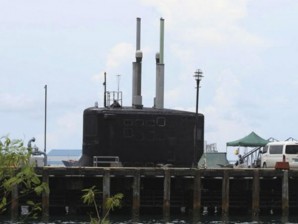
The Virginia class fast attack submarine USS North Carolina (SSN 777) is docked at Subic Freeport, in Zambales province west of Manila, Philippines Wednesday May 16, 2012. With a crew of 133, North Carolina arrived at Subic Bay Sunday May 13, 2012 as part of her Western Pacific deployment and according to Submarine Group 7 Public Affairs, is "one of the stealthiest, most technologically advanced submarines in the world." (AP Photo/Jun Dumaguing)
WASHINGTON—The Philippine President comes to the White House seeking assurance of U.S. military help should the Southeast Asian ally face attack by rising power China over their conflicting maritime claims.
That’s an awkward question for the U.S. as it seeks to enhance its Asian alliances without alarming Beijing. Philippine President Benigno Aquino III meets President Barack Obama Friday, against the backdrop of a two-month standoff between Philippine and Chinese vessels at a disputed shoal in the South China Sea.
China’s assertive behavior in those waters have served to bolster Manila’s 60-year alliance with Washington that thrived during the Cold War but ebbed after nationalist political forces prompted the closure of American military bases in 1992.
Aquino, the son of democracy heroes, has emerged as a willing partner of the U.S. as it looks to build a stronger presence in Southeast Asia, a region neglected during a decade of war in Afghanistan and Iraq. He’s won plaudits for combating corruption since winning election two years ago and has revived the impoverished nation’s economy. He’s sought Washington’s help in rebuilding a decrepit military that is in little shape to defend its territorial claims.
Last month, the U.S. handed to the Philippines a second Coast Guard cutter, following the transfer last year of a similar 45-year old vessel that has since become a flagship in the Philippine navy as the island nation increasingly focusses on its maritime security. Close U.S. ally Japan is also reportedly preparing to supply the Philippines with 10 smaller, new patrol vessels.
In a boost to his standing as a worthy ally, Aquino will meet with Obama at the Oval Office after a State Department luncheon hosted by Secretary of State Hillary Rodham Clinton. He met with senators Thursday.
In many ways, Aquino’s ambitions dovetail with the Obama administration’s as it executes its strategic “pivot.” The two sides are discussing how to enhance the U.S. military presence in the Philippines beyond the decade-long counterterrorism training mission in the country’s Muslim-minority south that involves hundreds of American troops.
While Manila is amenable to troop rotations, more military exercises and port visits, Philippine officials tell The Associated Press they want Washington to issue a clear public statement that the U.S. would come to the Philippines’ defense if it comes under attack, as provided under their mutual defense treaty. Washington has been unwilling to go beyond general pronouncements that it will comply with its obligations under the treaty. The officials spoke on condition of anonymity because of diplomatic sensitivities.
The U.S. needs to get along with China to prevent their strategic rivalry from spiralling into confrontation and would likely balk at a public declaration of the kind the Philippines is seeking. In the past week, tensions at the disputed Scarborough Shoal have receded a little, as China and the Philippines withdrew some vessels from a lagoon at the center of the standoff.
Patrick Cronin, director of the Asia-Pacific security program at the Center for a New American Security think tank in Washington, said Aquino is serious about defense modernization, but the U.S. and the Philippines need a measured approach in building the Philippines’ military capacity and in deterring Chinese coercion.
The U.S. has already sent strong messages in recent weeks about its determination to be viewed as a Pacific power.
Last month saw a rare stop by a U.S. submarine at Subic Bay, location of a former American naval base that faces the South China Sea. And in the past week, Defense Secretary Leon Panetta visited emerging strategic ally India and Vietnam — another South China Sea claimant at odds with China and forging closer relations with the United States. Panetta announced that 60 percent of the Navy’s fleet will be deployed to the Pacific by 2020, up from about 50 percent now.
One irritant in U.S.-Philippine ties is human rights. The Philippines wants Washington to lift a block on a small portion of U.S. aid imposed by Congress since 2008 because of concerns over extrajudicial killings, including by security forces. The killings have declined under Aquino, but the restriction remains as few suspected perpetrators have been arrested or prosecuted.
Human Rights Watch said that in the past decade, security forces have been implicated in hundreds of cases of extrajudicial killings, torture, and enforced disappearances. Only seven cases of extrajudicial killings, involving 11 defendants, have been successfully prosecuted; none since Aquino took power and none involving active duty military personnel, it said.